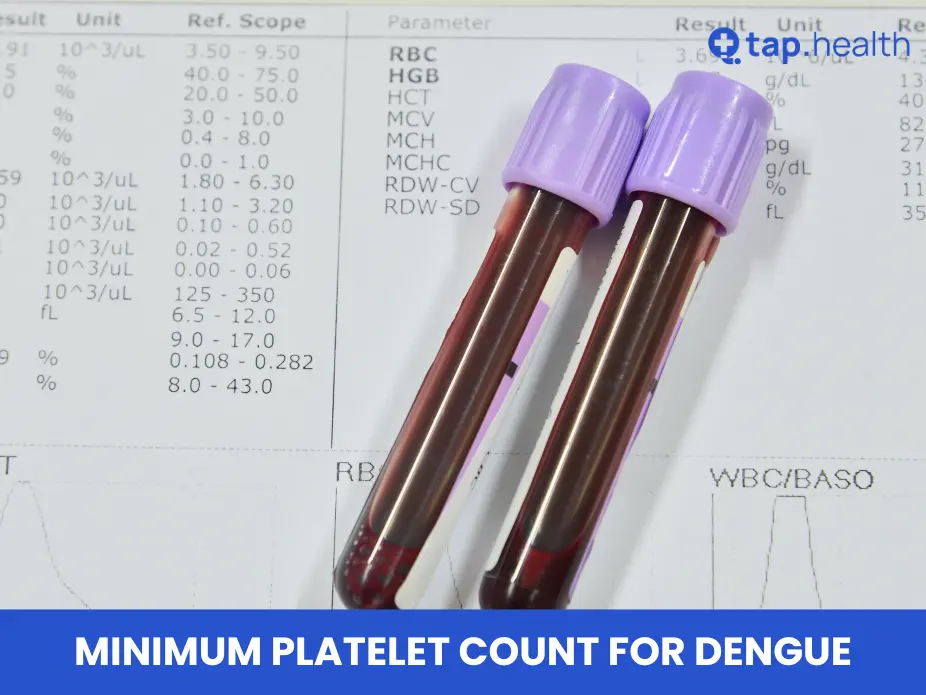Dengue is a mosquito-borne viral infection that poses a significant health risk in many tropical and subtropical regions around the world. One of the critical concerns in dengue patients is the drop in platelet count, which can lead to severe complications. Platelets are essential for blood clotting, and their depletion can result in bleeding and other serious issues. In this blog, we will explore the minimum platelet count for dengue, understand the disease, and delve into various aspects related to platelet count in dengue patients.
What is Dengue?
Dengue is a viral infection transmitted to humans through the bite of infected female Aedes mosquitoes, particularly Aedes aegypti and Aedes albopictus. The virus belongs to the Flaviviridae family and has four distinct serotypes: DEN-1, DEN-2, DEN-3, and DEN-4. Infection with one serotype provides lifelong immunity to that specific serotype but only partial and temporary immunity to the others. This means a person can be infected with Dengue up to four times in their lifetime, once with each serotype.
Symptoms of Dengue
The symptoms of dengue can range from mild to severe and typically appear 4 to 10 days after the bite of an infected mosquito. Common symptoms include:
- High fever
- Severe headache
- Pain behind the eyes
- Joint and muscle pain
- Rash
- Nausea and vomiting
- Mild bleeding (such as nosebleeds, gum bleeding, or easy bruising)
Types of Dengue
Dengue can be classified into several types, each with varying severity:
1. Classic Dengue Fever
- Also known as Dengue Fever (DF).
- Symptoms include high fever, severe headache, pain behind the eyes, muscle and joint pains, and rash.
2. Dengue Hemorrhagic Fever (DHF)
- A more severe form of dengue.
- Symptoms include all those of Dengue Fever plus bleeding tendencies (such as easy bruising, nose or gum bleeding, and possibly internal bleeding), blood plasma leakage, and low platelet count.
3. Dengue Shock Syndrome (DSS)
- The most severe form of dengue.
- Includes all symptoms of DHF plus severe abdominal pain, persistent vomiting, rapid breathing, blood in vomit and stool, and can lead to shock.
Dengue Platelets
Platelets, also known as thrombocytes, are small, colorless cell fragments in the blood that play a crucial role in hemostasis, the process that stops bleeding at the site of injured blood vessels.
Types of Dengue Platelets
1. Normal Platelets
- Essential for blood clotting.
- Normal count ranges from 150,000 to 450,000 per microliter of blood.
2. Low Platelets (Thrombocytopenia)
- A significant drop in count due to dengue infection.
- Can lead to severe bleeding complications if not monitored and managed properly.
Complete Understanding of Dengue Platelets Level Count
In dengue, the platelet count can drastically fall below the normal range of 150,000 to 450,000 per microliter of blood. Here is a breakdown of platelet count categories in dengue patients:
| Platelet Count (per cubic millimeter of blood) | Category |
|---|---|
| >100,000 | No risk |
| 40,000 – 100,000 | Low risk |
| 21,000 – 40,000 | Moderate risk |
| < 20,000 | High risk |
Why Do Platelets Drop in Dengue?
The significant drop in platelet count during dengue infection is caused by several factors:
1. Disrupted Platelet Production
The dengue virus can infiltrate the bone marrow, which is the factory where platelets are produced. This infiltration disrupts the normal production process, leading to fewer platelets being released into the bloodstream.
2. Increased Platelet Destruction
The dengue infection triggers the immune system to overreact. Sometimes, in its fight against the virus, the immune system mistakenly identifies healthy platelets as invaders and destroys them. This further contributes to the drop in dengue platelet count.
The Role of Platelets in the Body
Platelets, also known as thrombocytes, are small, colorless cell fragments in the blood that play a crucial role in hemostasis, the process that stops bleeding at the site of injured blood vessels. Here’s a detailed look at their functions:
1. Clot Formation
When a blood vessel is injured, platelets are among the first responders to the site of damage. They adhere to the exposed collagen fibers of the vessel wall and each other, forming a platelet plug. This initial plug is crucial in preventing further blood loss.
2. Release of Chemical Signals
Platelets release various chemicals that enhance the clotting process. These include ADP, thromboxane A2, and serotonin.
3. Interaction with Clotting Factors
Platelets provide a surface for the assembly of clotting factors, which are proteins in the blood plasma that work together to form a stable blood clot. This process is known as the coagulation cascade. The clotting factors convert fibrinogen, a soluble plasma protein, into fibrin, an insoluble protein that forms a mesh, stabilizing the platelet plug.
4. Wound Healing
Platelets contain growth factors such as Platelet-Derived Growth Factor (PDGF) and Transforming Growth Factor-beta (TGF-β). These growth factors are released at the site of injury and play a role in tissue repair and regeneration by attracting cells that contribute to wound healing.
What are the Symptoms Associated With Low Platelets in Dengue?
Dengue fever itself has a range of symptoms, but when it comes to low platelets specifically, there aren’t always tell-tale signs you’ll experience outwardly. This is why regular monitoring of platelet count is important during dengue. However, some signs might indicate a more serious situation due to low platelets:
1. Symptoms of Low Platelets in Dengue
a. Easy Bruising or Bleeding
One of the most common symptoms of low platelets in dengue.
- You might notice small purple spots on your skin (petechiae) or larger, flat, reddish-brown patches (ecchymosis) even from minor bumps or without any apparent cause.
- You might also experience bleeding from your nose, gums, or even internal bleeding, although these are less common.
b. Severe Abdominal Pain
Can be a sign of internal bleeding in the abdomen.
c. Vomiting Blood
A more serious sign and requires immediate medical attention.
d. Black Stools or Blood in the Urine
Signs of internal bleeding and require urgent medical attention.
How to Increase Platelet Count in Dengue?
Dengue fever can cause a significant drop in platelet count, raising concerns about bleeding complications. While medications and transfusions may be necessary in severe cases, there are steps you can take to support your body’s natural platelet production during recovery. Here’s how:
Dietary Strategies to Boost Platelet Production
Essential Nutrients
Focus on a balanced diet rich in vitamins and minerals that play a role in platelet production.
- Vitamin C: Citrus fruits (oranges, grapefruits), bell peppers, strawberries
- Vitamin B12: Lean meats, fish, eggs, dairy products
- Folate: Leafy green vegetables (spinach, kale), lentils, beans
- Vitamin K: Leafy greens, broccoli, asparagus
- Iron: Lean meats, beans, lentils, fortified cereals
Platelet-Friendly Foods
Some foods have been linked to increased platelet production, although more research is needed. Consider incorporating these into your diet:
- Papaya: Avoid eating papaya leaves as they also have toxins in them. Consume papaya instead.
- Pomegranate: This fruit is rich in antioxidants and may contribute to platelet health.
- Dates: Dates are a natural source of iron and other essential nutrients.
Hydration and Fluid Management
Staying well-hydrated is crucial for overall health and can also indirectly support platelet production. Aim to drink plenty of fluids throughout the day, especially water, clear broths, and coconut water. Avoid sugary drinks and excessive caffeine, which can dehydrate you.
Medical Considerations
Medications
In some cases, doctors may prescribe medications to stimulate the bone marrow to produce more platelets. These medications should only be taken under a doctor’s supervision.
Platelet Transfusions
If your platelet count drops critically low and you experience bleeding complications, a platelet transfusion as a part of your dengue fever treatment may be necessary. This is a medical procedure performed by a healthcare professional.
Treatment for Low Platelets in Dengue
1. Hospitalization
Severe cases of dengue with critically low platelet counts often require hospitalization for close monitoring and supportive care.
2. Intravenous Fluids
IV fluids may be administered to maintain hydration and support blood circulation.
3. Platelet Transfusions
If the platelet count drops dangerously low and there is a risk of bleeding, a platelet transfusion may be necessary.
Home Care and Monitoring for Low Platelets in Dengue
1. Rest and Hydration
Getting plenty of rest and staying well-hydrated is essential for recovery. Avoid strenuous activities that could increase the risk of bleeding.
2. Regular Monitoring
Regular monitoring of platelet counts and other vital signs is crucial. Follow your doctor’s advice on the frequency of blood tests and check-ups.
When to See a Doctor
Recognizing when to seek medical attention is crucial in managing dengue fever and its complications, particularly concerning platelet counts. Here are key signs indicating it’s time to consult a healthcare professional:
- Persistent High Fever: If your fever remains high for more than a few days despite treatment, seek medical advice.
- Severe Abdominal Pain: This can indicate internal bleeding and requires immediate attention.
- Uncontrolled Vomiting: Persistent vomiting can lead to dehydration and needs medical intervention.
- Bleeding: Any sign of unusual bleeding, such as from the gums, nose, or in the stool, should prompt an immediate visit to the doctor.
- Extreme Fatigue: If you feel unusually weak or fatigued, it might be due to low platelet levels and other complications.
- Confusion or Disorientation: Changes in mental status can be a sign of severe illness and require urgent care.
FAQ on Minimum Platelet Count for Dengue
1. What is the Minimum Platelet Count Considered Safe in Dengue?
A platelet count above 100,000 per cubic millimetre is generally considered safe. Counts below this threshold may require closer monitoring and intervention.
2. How Quickly Can Platelet Counts Drop in Dengue?
Platelet counts can drop rapidly in the acute phase of dengue, often within a few days of symptom onset.
3. Can Platelet Counts Recover on Their Own?
Yes, with proper medical care and supportive treatments, platelet counts can recover as the body fights off the dengue virus.
4. Are There Natural Ways to Boost Platelet Count?
While diet and hydration can support overall health, medical interventions may be necessary for critically low platelet counts.
5. When Should Platelet Transfusions Be Considered?
Transfusions are typically considered when platelet counts drop below 20,000 per cubic millimetre or if there are signs of significant bleeding.
Understanding the minimum platelet count for dengue and its implications is crucial for managing this disease effectively. With timely medical intervention and supportive care, most patients can recover fully from dengue and its complications.



